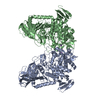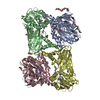+ Open data
Open data
- Basic information
Basic information
| Entry | Database: PDB / ID: 6zd0 | ||||||
|---|---|---|---|---|---|---|---|
| Title | Disulfide-locked early prepore intermedilysin-CD59 | ||||||
 Components Components |
| ||||||
 Keywords Keywords |  TOXIN / early prepore / TOXIN / early prepore /  membrane-bound / membrane-bound /  oligomer oligomer | ||||||
| Function / homology |  Function and homology information Function and homology informationnegative regulation of activation of membrane attack complex / complement binding /  regulation of complement-dependent cytotoxicity / regulation of complement-dependent cytotoxicity /  regulation of complement activation / Cargo concentration in the ER / COPII-mediated vesicle transport / regulation of complement activation / Cargo concentration in the ER / COPII-mediated vesicle transport /  cholesterol binding / tertiary granule membrane / specific granule membrane / COPI-mediated anterograde transport ...negative regulation of activation of membrane attack complex / complement binding / cholesterol binding / tertiary granule membrane / specific granule membrane / COPI-mediated anterograde transport ...negative regulation of activation of membrane attack complex / complement binding /  regulation of complement-dependent cytotoxicity / regulation of complement-dependent cytotoxicity /  regulation of complement activation / Cargo concentration in the ER / COPII-mediated vesicle transport / regulation of complement activation / Cargo concentration in the ER / COPII-mediated vesicle transport /  cholesterol binding / tertiary granule membrane / specific granule membrane / COPI-mediated anterograde transport / cholesterol binding / tertiary granule membrane / specific granule membrane / COPI-mediated anterograde transport /  transport vesicle / endoplasmic reticulum-Golgi intermediate compartment membrane / transport vesicle / endoplasmic reticulum-Golgi intermediate compartment membrane /  Regulation of Complement cascade / ER to Golgi transport vesicle membrane / Regulation of Complement cascade / ER to Golgi transport vesicle membrane /  blood coagulation / blood coagulation /  toxin activity / killing of cells of another organism / vesicle / cell surface receptor signaling pathway / external side of plasma membrane / toxin activity / killing of cells of another organism / vesicle / cell surface receptor signaling pathway / external side of plasma membrane /  Golgi membrane / Golgi membrane /  focal adhesion / Neutrophil degranulation / endoplasmic reticulum membrane / host cell plasma membrane / focal adhesion / Neutrophil degranulation / endoplasmic reticulum membrane / host cell plasma membrane /  cell surface / cell surface /  extracellular space / extracellular exosome / extracellular region / extracellular space / extracellular exosome / extracellular region /  membrane / membrane /  metal ion binding / metal ion binding /  plasma membrane plasma membraneSimilarity search - Function | ||||||
| Biological species |   Streptococcus intermedius (bacteria) Streptococcus intermedius (bacteria)  Homo sapiens (human) Homo sapiens (human) | ||||||
| Method |  ELECTRON MICROSCOPY / ELECTRON MICROSCOPY /  single particle reconstruction / single particle reconstruction /  cryo EM / Resolution: 4.6 Å cryo EM / Resolution: 4.6 Å | ||||||
 Authors Authors | Shah, N.R. / Bubeck, D. | ||||||
| Funding support |  United Kingdom, 1items United Kingdom, 1items
| ||||||
 Citation Citation |  Journal: Nat Commun / Year: 2020 Journal: Nat Commun / Year: 2020Title: Structural basis for tuning activity and membrane specificity of bacterial cytolysins. Authors: Nita R Shah / Tomas B Voisin / Edward S Parsons / Courtney M Boyd / Bart W Hoogenboom / Doryen Bubeck /  Abstract: Cholesterol-dependent cytolysins (CDCs) are pore-forming proteins that serve as major virulence factors for pathogenic bacteria. They target eukaryotic cells using different mechanisms, but all ...Cholesterol-dependent cytolysins (CDCs) are pore-forming proteins that serve as major virulence factors for pathogenic bacteria. They target eukaryotic cells using different mechanisms, but all require the presence of cholesterol to pierce lipid bilayers. How CDCs use cholesterol to selectively lyse cells is essential for understanding virulence strategies of several pathogenic bacteria, and for repurposing CDCs to kill new cellular targets. Here we address that question by trapping an early state of pore formation for the CDC intermedilysin, bound to the human immune receptor CD59 in a nanodisc model membrane. Our cryo electron microscopy map reveals structural transitions required for oligomerization, which include the lateral movement of a key amphipathic helix. We demonstrate that the charge of this helix is crucial for tuning lytic activity of CDCs. Furthermore, we discover modifications that overcome the requirement of cholesterol for membrane rupture, which may facilitate engineering the target-cell specificity of pore-forming proteins. | ||||||
| History |
|
- Structure visualization
Structure visualization
| Movie |
 Movie viewer Movie viewer |
|---|---|
| Structure viewer | Molecule:  Molmil Molmil Jmol/JSmol Jmol/JSmol |
- Downloads & links
Downloads & links
- Download
Download
| PDBx/mmCIF format |  6zd0.cif.gz 6zd0.cif.gz | 253.5 KB | Display |  PDBx/mmCIF format PDBx/mmCIF format |
|---|---|---|---|---|
| PDB format |  pdb6zd0.ent.gz pdb6zd0.ent.gz | 175.5 KB | Display |  PDB format PDB format |
| PDBx/mmJSON format |  6zd0.json.gz 6zd0.json.gz | Tree view |  PDBx/mmJSON format PDBx/mmJSON format | |
| Others |  Other downloads Other downloads |
-Validation report
| Arichive directory |  https://data.pdbj.org/pub/pdb/validation_reports/zd/6zd0 https://data.pdbj.org/pub/pdb/validation_reports/zd/6zd0 ftp://data.pdbj.org/pub/pdb/validation_reports/zd/6zd0 ftp://data.pdbj.org/pub/pdb/validation_reports/zd/6zd0 | HTTPS FTP |
|---|
-Related structure data
| Related structure data |  11172MC M: map data used to model this data C: citing same article ( |
|---|---|
| Similar structure data |
- Links
Links
- Assembly
Assembly
| Deposited unit | 
|
|---|---|
| 1 |
|
- Components
Components
| #1: Protein |  Cholesterol-dependent cytolysin Cholesterol-dependent cytolysinMass: 59100.953 Da / Num. of mol.: 3 / Mutation: I104C G244C Source method: isolated from a genetically manipulated source Source: (gene. exp.)   Streptococcus intermedius (bacteria) / Gene: ily / Plasmid: pTricHis / Details (production host): IPTG-inducable promoter / Production host: Streptococcus intermedius (bacteria) / Gene: ily / Plasmid: pTricHis / Details (production host): IPTG-inducable promoter / Production host:   Escherichia coli BL21(DE3) (bacteria) / References: UniProt: Q9LCB8 Escherichia coli BL21(DE3) (bacteria) / References: UniProt: Q9LCB8#2: Protein | Mass: 9204.445 Da / Num. of mol.: 3 Source method: isolated from a genetically manipulated source Source: (gene. exp.)   Homo sapiens (human) / Gene: CD59, MIC11, MIN1, MIN2, MIN3, MSK21 / Production host: Homo sapiens (human) / Gene: CD59, MIC11, MIN1, MIN2, MIN3, MSK21 / Production host:   Escherichia coli (E. coli) / References: UniProt: P13987 Escherichia coli (E. coli) / References: UniProt: P13987 |
|---|
-Experimental details
-Experiment
| Experiment | Method:  ELECTRON MICROSCOPY ELECTRON MICROSCOPY |
|---|---|
| EM experiment | Aggregation state: PARTICLE / 3D reconstruction method:  single particle reconstruction single particle reconstruction |
- Sample preparation
Sample preparation
| Component |
| ||||||||||||||||||||||||||||
|---|---|---|---|---|---|---|---|---|---|---|---|---|---|---|---|---|---|---|---|---|---|---|---|---|---|---|---|---|---|
| Molecular weight |
| ||||||||||||||||||||||||||||
| Source (natural) |
| ||||||||||||||||||||||||||||
| Source (recombinant) |
| ||||||||||||||||||||||||||||
| Buffer solution | pH: 7.5 | ||||||||||||||||||||||||||||
| Buffer component |
| ||||||||||||||||||||||||||||
| Specimen | Embedding applied: NO / Shadowing applied: NO / Staining applied : NO / Vitrification applied : NO / Vitrification applied : YES : YES | ||||||||||||||||||||||||||||
| Specimen support | Details: Grids were glow discharged before application of graphene oxide, then left to dry for 1 hour before use. Grid material: COPPER / Grid mesh size: 400 divisions/in. / Grid type: Quantifoil R1.2/1.3 | ||||||||||||||||||||||||||||
Vitrification | Instrument: FEI VITROBOT MARK III / Cryogen name: ETHANE / Humidity: 95 % / Chamber temperature: 294 K / Details: Wait time of 60 s, blot time 2.5 s, blot force 3 |
- Electron microscopy imaging
Electron microscopy imaging
| Experimental equipment |  Model: Titan Krios / Image courtesy: FEI Company |
|---|---|
| Microscopy | Model: FEI TITAN KRIOS / Details: Pixel size 1.4 A |
| Electron gun | Electron source : :  FIELD EMISSION GUN / Accelerating voltage: 300 kV / Illumination mode: FLOOD BEAM FIELD EMISSION GUN / Accelerating voltage: 300 kV / Illumination mode: FLOOD BEAM |
| Electron lens | Mode: BRIGHT FIELD Bright-field microscopy / Nominal defocus max: 3100 nm / Nominal defocus min: 1900 nm / Cs Bright-field microscopy / Nominal defocus max: 3100 nm / Nominal defocus min: 1900 nm / Cs : 2.7 mm / C2 aperture diameter: 100 µm / Alignment procedure: COMA FREE : 2.7 mm / C2 aperture diameter: 100 µm / Alignment procedure: COMA FREE |
| Specimen holder | Cryogen: NITROGEN / Specimen holder model: FEI TITAN KRIOS AUTOGRID HOLDER |
| Image recording | Average exposure time: 1 sec. / Electron dose: 66 e/Å2 / Detector mode: INTEGRATING / Film or detector model: FEI FALCON III (4k x 4k) Details: Some images were collected at a 30 degree tilt. Images were collected in movie mode at 39 frames per second. |
- Processing
Processing
| EM software |
| ||||||||||||||||||||||||||||||||||||||||||||
|---|---|---|---|---|---|---|---|---|---|---|---|---|---|---|---|---|---|---|---|---|---|---|---|---|---|---|---|---|---|---|---|---|---|---|---|---|---|---|---|---|---|---|---|---|---|
CTF correction | Type: NONE | ||||||||||||||||||||||||||||||||||||||||||||
3D reconstruction | Resolution: 4.6 Å / Resolution method: FSC 0.143 CUT-OFF / Num. of particles: 51041 / Num. of class averages: 2 / Symmetry type: POINT | ||||||||||||||||||||||||||||||||||||||||||||
| Atomic model building | Protocol: RIGID BODY FIT / Space: REAL Details: Model of ILY-CD59 was fit and refined into the central subunit density. A combination of rigid body fitting and global minimization with secondary structure restraints was used to fit and ...Details: Model of ILY-CD59 was fit and refined into the central subunit density. A combination of rigid body fitting and global minimization with secondary structure restraints was used to fit and refine the central subunit model. Then the central subunit model was rigid body fit as one body into the neighbouring subunits to generate a 3 subunit oligomer model. | ||||||||||||||||||||||||||||||||||||||||||||
| Atomic model building | PDB-ID: 4BIK Accession code: 4BIK / Source name: PDB / Type: experimental model |
 Movie
Movie Controller
Controller











 PDBj
PDBj






